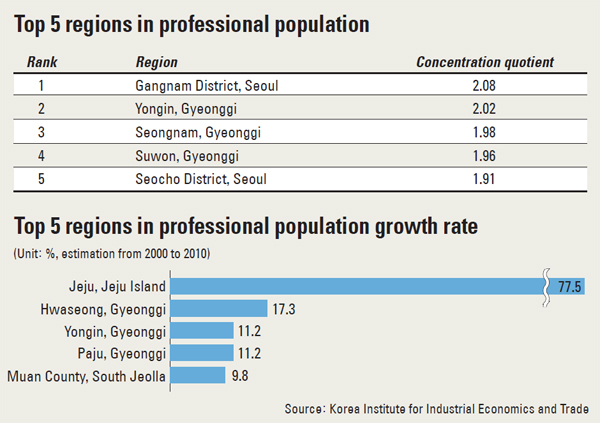Study tracks movements, growth of creative class

Behind Gangnam were Yongin and Seongnam, both in Gyeonggi.
Daejeon was the only city outside the Seoul metropolitan area in the top 10, thanks to its special science and technology R&D zone in Yuseong District.
The report is based on 2000-10 data from about 230 local governments.
The study was conducted based on three occupation categories as part of the “creative class” theory developed by Richard Florida, a business economics professor at the University of Toronto. The categories are the “creative core,” which generates new value and content and includes scientists, engineers and IT professionals; “creative professionals,” including public and private sector managers, lawyers and financiers; and “Bohemians” engaged in culture and sports.
The report said creative professionals tend to reside in urban areas where manufacturers and professional service providers, including legal and consulting firms and R&D centers, are based.
With the creative class growing by 1.9 percent annually during the study period to five million people, or 22 percent of the work force, midsize cities of 300,000 to one million in population showed the fastest creative class growth rate of 6.7 percent a year and the rate for cities of less than 300,000 was about 5 percent annually.
Major metropolitan cities grew only 1 percent, largely due to an exodus of creative professionals to midsize cities, according to the report. Counties saw 9 percent of their innovation leaders move to midsize cities.
The report explained that midsize cities enjoyed a high growth rate, thanks to industrial development initiatives. Paju, Gyeonggi, showed 11.2 percent population growth, fourth highest in the study, as the government made it a technology cluster for the display industry.
Muan County, South Jeolla, recorded a 10 percent growth to rank fifth after the provincial office relocated from Gwangju.
However, Kim Young-soo, a fellow at the institute’s Research Center for Regional Development, emphasized the study showed that balanced regional development is a more efficient way to attract membersof the creative class to an area, because they tend to choose places that offer a good quality of life.
“It is more effective to encourage policies that target general population growth and overall job creation, instead of specialized regional development limited to certain industries,” said Kim.
BY kim ji-yoon [jiyoon.kim@joongang.co.kr]










with the Korea JoongAng Daily
To write comments, please log in to one of the accounts.
Standards Board Policy (0/250자)